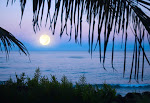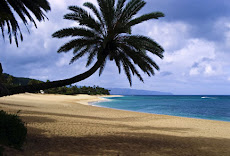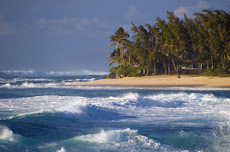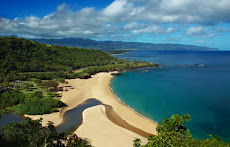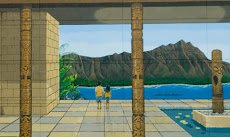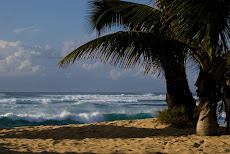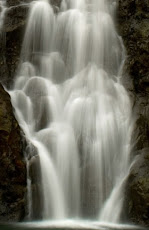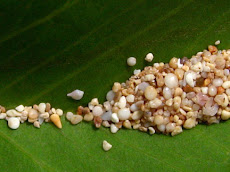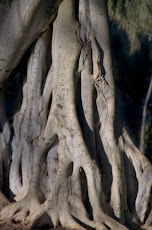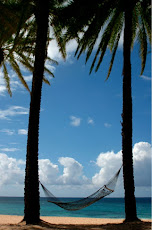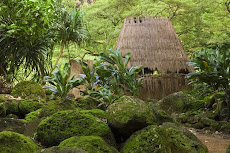 Blue Planet Foundation's mission statement is
Blue Planet Foundation's mission statement is . . . To change our world's energy culture
Hawai'i is a microcosm of our Earth. A location many think of as paradise. A perfect place to completely change our dependence on oil. Hawai'i has abundant natural resources ~ wind, waves, sunshine and geothermal (volcanic).
The island of O'ahu (The Gathering Place), opened its arms with aloha to host
The Blue Planet Global Energy Summit from April 3rd through the 5th. This was
Blue Planet Foundation's first annual Summit for strategizing as well as beginning to put into effect programs regarding energy issues.
Major changes are needed to meet our energy needs today and for our future. Moving toward change requires cooperation, communication, and understanding across various interest groups, industries and national boundaries. This can be done, according to
Blue Planet Foundation, if there is a new vision for the way energy is generated, distributed and used.
 Philanthropist Henk Rogers
Philanthropist Henk Rogers founded the
Blue Planet Foundation because of his commitment to our environment. As a result of his entrepreneurship in the computer-technology-world, Rogers was able to pull together a very positive Summit for brainstorming and promoting the use of non-carbon, environmentally-friendly, clean energy sources while also talking about the economic benefits of protecting our environment. The three-day event was taped for two high-profile upcoming television shows. DVD's for academic, legislative and civic use will also be available offering inspiration to people around our world. Rogers believes the human imagination has the power and ability to solve our energy challenge.
 Over sixty influential leaders
Over sixty influential leaders in the environmental and energy fields participated in the Summit. Well-known speakers such as
Robert F. Kennedy Jr. (environmental attorney, author, activist),
Denis Hayes (Earth Day Founder, Professor,

President of the Bullitt Foundation),
Solomon Enos (kanaka maoli artist, helping organic MA'O Farms get off the ground),

Dr. Heidi Cullen (scientist, climate expert at the Weather Channel), Ramsay Taum (Director of External Relations and Community Partnerships at the University of Hawa'i School of Travel Industry Management and Co-Director of Sustain Hawai'i), and
Dr. Stephen H. Schneider (Nobel Prize winner and

Professor) were just a few of the
speakers that participated in the Summit.
Not Just Talk, but Action! Blue Planet Foundation has teamed up with
Evolution Sage
to create an innovative Energy Returned on Energy Invested Program with Nanakuli High School that not only educates, but involves students in conserving energy as well as integrating what they learn about alternative solutions in order to make their school and their homes more energy efficient.
Kevin Vaccarello, Executive Director of
Evolution Sage, (video) and Founder, Co-Executive Director of Sustain Hawai'i presented a brief overview of the
Energy Invested Program's hands-on approach that will teach the students at Nanakuli High School how they can personally affect change in the real world.
To make this learning experience even more beneficial to the students, they will be asked to submit a "Walk Story with Blue Planet" Essay via
Blue Planetʻs website and explain what the energy, water and money saved means to them, their family, their community and their world. The best 20+ essays will win a partial energy and water efficiency retrofit for their homes in the way of LED bulbs, faucet aerators, and low-flow showerheads (they're better than they used to be) .
Their project isn't over yet!! After having their homes retrofitted, the Nanakuli High School students will track the difference in energy and water consumption from the previous year to determine how much energy, water and money their family is saving.
The families will pledge to use those savings to further support the studentʻs education or use it for more sustainability-oriented solutions. Each household should save nearly $300/yr for

over 20 years, which cumulatively for all households is more than $150,000 over the lifetime of the LED bulbs, low-flow showerheads and faucet aerators.
This pilot program can be used in schools throughout the country and world.
By actually participating in bettering ones life, the students as well as their teachers, will bring a new perspective to their energy uses, and the knowledge they have acquired will ripple through their family and community in many positive ways. Nanakuli's Principal, Darin Pilialoha is an enthusiastic supporter of the program.
I wouldn't be surprised if this Program generates even more innovative energy idea's generated by the students themselves.
Student's Share Their Concerns

An important component in the discussion, was that of Students from around the world. It's vital that the younger generations have a prominent voice at all discussions - they are the future leaders, and have much to offer.

The student environmental activists from near and far were: Chelsea Chee (Navajo Nation), Erda Rindrasih (Indonesia) Cristian Beccera Monroy (Mexico), Anna Rose (Australia), Silvia Gianetti Barber (University of Hawai'i) & Shanah Trevenna (University of Hawai'i)
 Tracking Our Progress in Hawai'i
Tracking Our Progress in Hawai'iHawaii can play a lead role in advancing the use of the many alternative energies presently available to us. As people voice their commitment to change, the political leaders will follow. Blue Planet Foundation and the participants of the Summit will return next year to share their accomplishments, and talk about the positive changes they've seen.
Every Positive Action Does Help!For in-depth information on the Summit, go to
Blue Planet SummitPhoto Gallery of the Blue Planet Summit































